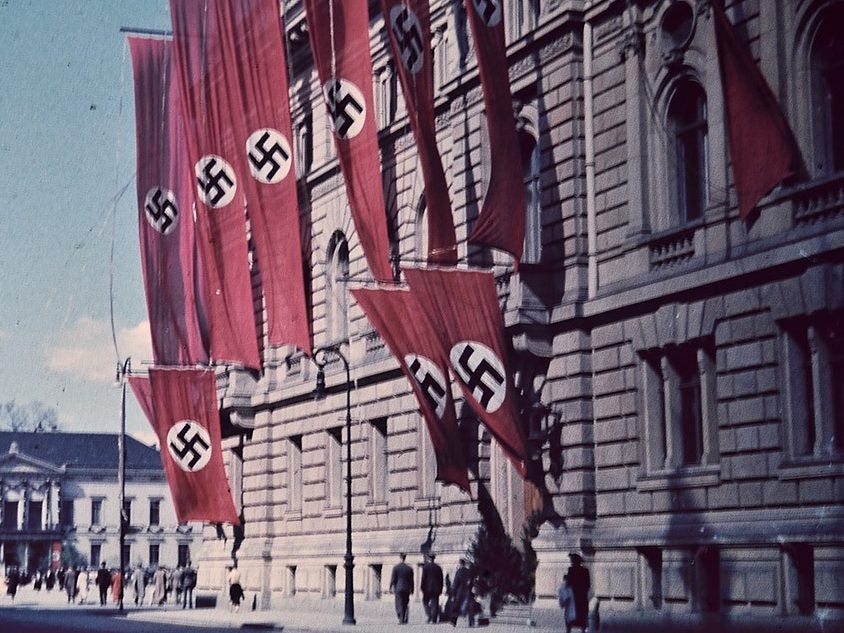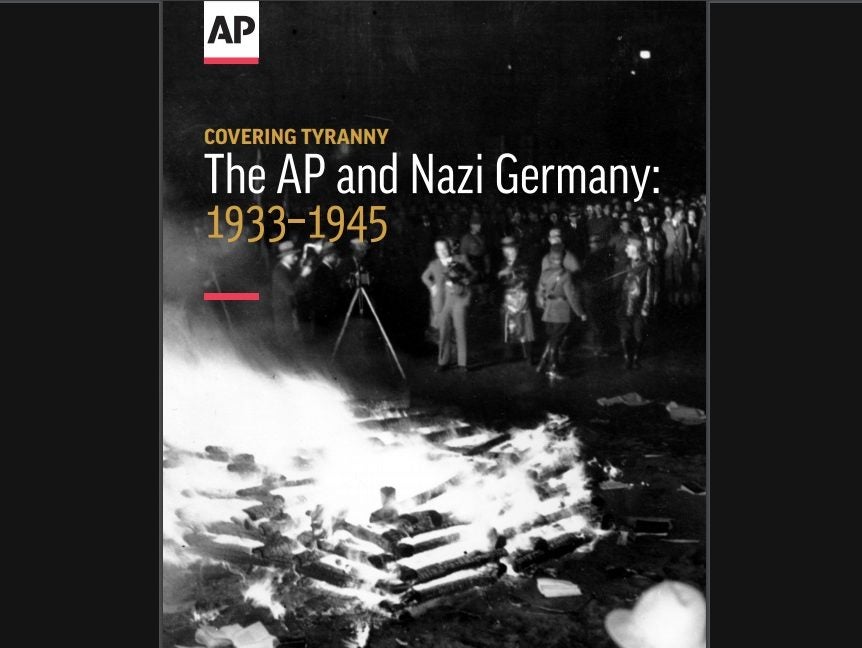
The Associated Press (AP) has said claims it was complicit in helping the Nazi regime while reporting from Germany in the 1930s are “simply wrong”, following an “exhaustive review” of its past operations.
AP’s review was carried out after German historian Harriet Scharnberg claimed in an academic paper that the agency’s pictures had been used by Hitler’s propagandists and some of its staff worked for the Nazi party.
The US news agency said in a report published yesterday that it had acted as “forthrightly and independently as possible” in reporting on Nazi Germany, but admitted it had “handled some situations inadequately”.
AP opened a Berlin bureau in 1931, but chose not to close it when two years later Hitler rose to power and it was brought under the supervision of the Nazi Ministry of Propaganda, along with all other German media.
During this time, the agency gathered news and collected and sold photos in Germany through its local service. Some images were sent to New York, where they were distributed to AP’s 1,400 American newspaper members.
The bureau continued operating until 1941, when AP was expelled from Germany because America had entered the Second World War. Its office was then put under the charge of an SS photographer called Helmut Laux.
Most German former AP personnel were forced into Laux’s operation while others were sent to military units. AP’s American staff members were arrested and interned for five months before being deported in a prisoner exchange.
Scharnberg claimed the agency had been complicit with the Nazi regime – a claim disputed by AP – by agreeing to the restrictive Ministry of Propaganda laws in keeping its Berlin bureau open.
She said AP pictures from Germany had been used in anti-Semitic literature and that some German AP photographers were drafted into or joined Nazi military propaganda units when war broke out in 1939, some while still being paid by the agency.
Scharnberg’s research was published in the academic journal Studies in Contemporary History last year and was reported by the Guardian.
In her paper, Scharnberg said: “The third largest news picture agency, Associated Press, chose not to close its Berlin subsidiary. Instead it accepted the [Nazi] Editors’ Law, thus ceding considerable influence over the production of its news pictures to the Ministry of Propaganda both in terms of staff and the content of the images themselves.
She added: “It is doubtful that AP revealed to its subscribers the fact, surely considered scandalous even then, that many of its German pictures were from the camera of an SS man.”
By way of example, Scharnberg claimed more than half of the pictures used in an “inflammatory” Nazi pamphlet from 1939, titled: “The Jews in the USA. More than 100 pictures”, held an AP copyright, adding: “This was by no means an isolated case.”
In reviewing its past conduct, the agency explored unexamined AP archives, US military documents and the oral histories and personal papers of deceased employees. Scharnberg was also interviewed
John Daniszewski, AP’s vice president and editor at large for standards, explained: “AP believes it is important to know one’s own story – warts and all – and so we have re-examined the period, taking a hard look.”
A report on its findings was compiled by Larry Heinzerling, an assistant professor at the Columbia Graduate School of Journalism and retired AP deputy international editor, with contributions by AP investigative researcher Randy Herschaft.

The front page of APs report on its operations in Nazi Germany. Picture: AP
The report stated: “Viewed from the perspective of more than 80 years’ hindsight, the AP in the totality of its conduct fulfilled its mission to gather the news in Germany forthrightly and as independently as possible for the benefit of its audience and for the benefit of the truth.
“We recognize that AP should have done some things differently during this period, for example protesting when AP photos were exploited by the Nazis for propaganda within Germany and refusing to employ German photographers with active political affiliations and loyalties, whether to the Nazis or any party.
“However, suggestions that AP at any point sought to help the Nazis or their heinous cause are simply wrong. Due in large part to the AP’s aggressive reporting, the dangers of the Nazis’ ambitions for domination in Europe and their brutal treatment of its opponents were revealed to the wider world.”
The report also highlights instances in which AP editors “clashed” with Nazi censors and also demanded “stronger steps” be taken to keep the AP German photo service free of Nazi propaganda.
It also references AP reporting in the 1930s that “alerted readers in the United States to the acts of anti-Semitism and cruelty of the Nazi regime both in words and photos”.
AP executive editor Sally Buzbee said: “It is essential to cover tyrannical regimes and other undemocratic movements, when possible from within the borders they control, in order to accurately relay what is happening inside.
“That is what we do, without compromising AP’s independence or standards.”
Report key findings (source AP):
For the period 1933-41:
- While AP management insisted that its German photo service production stay neutral, German staff members faced constant pressure from Propaganda Ministry officials about AP’s photo output, “with some doing a better job of resisting Nazi demands than others”.
- AP’s photo captions when they appeared in German media often were rewritten or published under misleading or offensive headlines.
- While the AP protested and fought against Nazi attempts to censor the AP itself, the review found no evidence that AP protested these abuses by pro-Nazi media. Current AP practice requires a strong response when AP customers willfully distort the meaning of AP content.
- After resisting for two years, the AP in late 1935 submitted to an anti-Semitic edict that all people working in German media must be of German “Aryan” origin. AP’s German photo service let go six employees considered Jewish by the Nazis, while helping them to find work elsewhere. “The AP made the difficult decision to comply because it believed it was critical for AP to remain in Germany and gather news and photos during this crucial period,” the report said. With AP’s aid, all of these employees emigrated and survived the Holocaust.
- AP’s Berlin-based American reporters and German photographers covered the first part of the Second World War from 1939-41 from the German side of the battle lines. The US had not yet entered the war but some of this coverage was criticised from within the US Embassy in Berlin as channelling German official views and disinformation. AP executives in New York assessed the accusations and rejected the criticism, stating that AP reports reflected events as seen by the reporters.
- A few of AP’s German employees held pro-Nazi views and covered the German side of the war enthusiastically. One staff and then freelance photographer employed by the AP German service was Austrian-born Franz Roth, an ardent Nazi who traveled as a war photographer with the Waffen SS to several fronts before and after the AP’s expulsion from Germany. He died as a combat photographer in 1943.
- After 1939, the German government drafted several AP German photo service employees to serve with propaganda units accompanying troops to cover the fighting, requiring that the resulting photos be pooled for use by German media while their salaries still were paid by AP Germany. AP management at the time believed their photography had news value in spite of the restrictions caused by travelling with German forces.
For the period 1942-45:
- In exchange, with the knowledge and approval of US wartime officials, AP sent photographs from the US to neutral countries for ultimate distribution inside Germany. The exchange was approved by AP’s New York headquarters and AP annual reports at the time made public that the AP was receiving photos from Nazi German-occupied areas. With one known exception, the AP report says, the AP images that appeared in German publications through this arrangement during the war were unaltered by the Germans, but captions were rewritten by German propagandists to conform to official Nazi views. According to the report, AP’s management in New York considered obtaining the German photos an important way to fulfil its mission to cover the war as comprehensively as possible. The report said: “Although the exchange necessitated dealing with the Nazi regime, it was the AP’s belief then and now that the photos gave the U.S. public a much fuller picture of the war than could have been obtained otherwise. That included scenes of fighting on the Russian front, the results of bombings of German cities and Germany’s falling war fortunes.”
Picture: Wikimedia/Pixabay
Email pged@pressgazette.co.uk to point out mistakes, provide story tips or send in a letter for publication on our "Letters Page" blog

